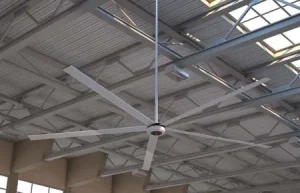Stuffy, uncomfortable rooms can hamper productivity and raise energy bills, especially in large or busy spaces. Regular fans often fail to circulate air at scale, leaving stagnant pockets of hot or cold. An HVLS fan provides a better, low-speed solution, moving more air and enhancing comfort for everyone below.
The main difference between an HVLS fan and a regular fan lies in their high volume, low-speed design and coverage area. HVLS fans are typically larger in diameter (up to 24 feet) and revolve slowly to circulate vast volumes of air, ideal for commercial and industrial spaces. A regular fan, like a box fan or a small ceiling fan, runs at a higher speed but handles less coverage. Hence, HVLS fans use fewer rotations to move more air efficiently across large areas.

HVLS Fan Visual
Many business owners and facility managers wonder if a standard ceiling fan or common box fans will suffice. Meanwhile, others see mentions of “HVLS fans vs normal fans” and wonder about the real differences. Doing a fans vs style comparison is crucial for making an informed decision about energy costs, coverage, and occupant comfort.
Case Study: A small gym tried many small fans but struggled with hot corners. After installing a single HVLS fan, the entire area enjoyed uniform temperature. Over time, the gym reduced AC usage and saw an improvement in occupant satisfaction.
Key differences emerge when we compare a typical ceiling fan to an HVLS fan:
| Feature | HVLS Fan | Regular Ceiling Fan |
|---|---|---|
| Size | Can span 24 feet in diameter (sometimes more) | Typically 3–5 feet in diameter |
| Speed | Low-speed operation, distributing a high volume of air at slow speeds | Higher speed (spins faster but covers less area) |
| Coverage | Ideal for commercial and industrial settings or vast spaces | Best for homes, offices, or small rooms |
| Airflow | Moves a large volume of air with minimal energy; fosters broad air circulation | Smaller footprint; mostly direct breeze in localized areas |
| Energy Efficiency | Typically greater energy efficiency if used to supplement or replace multiple small fans | Varies, but often less coverage per watt |
HVLS fans are built for large or open areas. While some residential fans might be decorative, HVLS stands for High Volume Low Speed—a specialized design that shifts massive volume of air gently.
HVLS fans are designed with wide blade spans, typically ranging from 8 feet to 24 feet. These broad blades move more air with each rotation. Rather than a higher speed approach, the low-speed fan method ensures coverage at minimal power usage.
HVLS fans also incorporate advanced motors and balanced blade designs. This ensures stable airflow without wobbling or vibration. The entire approach improves occupant comfort for big facilities.
“What makes HVLS fans stand out is their ability to harness gentle movements to cool an entire area,” says a spokesperson from our hvls fans manufacturing facility.
Proper air circulation is vital in large buildings, particularly in a warehouse or a spacious gym. Without sufficient movement, warm or stale air builds up, harming air quality and occupant comfort. This can drive up cooling bills as well, since many facilities overuse air conditioning to compensate for hot spots.
HVLS fan can replace multiple smaller fans thanks to its broad coverage. That’s especially helpful in commercial warehouses or manufacturing plants where consistent air throughout the floor is critical.

HVLS Fan in a Large Warehouse
The residential fan difference lies in scope, engineering, and usage. While you might see a wide variety of residential fans in people’s homes—from box fans to desk fans—these devices aim to cool a smaller zone. By contrast, an HVLS fan focuses on air circulation in large open spaces, like a warehouse or an auditorium.
Residential fan difference often is that they handle smaller zones at higher speed. They also prioritize aesthetics. Meanwhile, hvls and residential fans differ in scale, power, and the volume of air they move air with each rotation.
Quote: “When compared to residential fans, HVLS technology addresses coverage for thousands of square feet,” notes a facility manager from a local hunter industrial distribution center.
Fan is right for your building depends on size, occupant density, and ceiling height. In a small office with standard 8-foot ceilings, a typical ceiling fan suffices. However, for a 40-foot tall warehouse, an hvls fan offers better energy efficiency and coverage.
“Right fan for your space is crucial,” shares a product specialist from our hvls fans manufacturing line. “You don’t want to overspend on a huge fan for a tiny area—or, worse, use multiple regular fans that fail to reduce stagnant air in a warehouse.”
There are many advantages of hvls solutions. While traditional fans may effectively blow air in confined areas, HVLS can manage vast spaces with minimal effort. We typically see them in aviation hangars, big gyms, or distribution centers because they’re well-suited for large commercial and industrial spaces.
HVLS fans provide a stable environment, so your staff or guests remain comfortable year-round. Even in winter, HVLS can push rising hot air back down, contributing to fewer heating cycles.

Why Fans Are Better for Large Settings
The debate around fans vs HVLS centers on operational style. A traditional fan (like a box or desk model) typically spins at a higher speed but covers only small zones. Conversely, an HVLS relies on low-speed rotation, creating broad, gentle breezes.
HVLS fans spin at around 50–120 RPM, whereas smaller fans spin faster (e.g., 300–500+ RPM). The bigger diameter plus slow RPM equals wide coverage with minimal power consumption. Meanwhile, traditional fans may not have the power to move air effectively throughout huge spaces, requiring multiple units or leading to uneven cooling.
HVLS fans operate beyond the classic context of a warehouse. While these big devices are often found swirling overhead in distribution centers, they also thrive in:
Fans are often considered for sports arenas, large restaurants, or open-market halls. Additionally, they support the production line in factories by improving comfort and productivity.
hvls fans consume less energy than running multiple smaller fans, making them appealing in green initiatives or commercial and industrial sustainability programs.
The choice between a low-speed fan or a standard, fast-spinning fan depends on your area’s shape, occupant load, and climate objectives. If you manage a warehouse with 30-foot ceiling height, the more powerful coverage from an HVLS might outperform any “fans are smaller” approach.
Fact: HVLS fans move a broad volume of air at low speeds, so you can skip installing multiple pedestal or desk fans. One large HVLS outperforms numerous smaller devices in terms of coverage and efficiency.
How do HVLS fans differ from regular fans in terms of airflow?
HVLS fans move a large volume of air slowly, covering extensive floor space. Regular fans typically produce a fast, concentrated breeze in a limited zone.
Do HVLS fans require extra structural support?
Large fan type units, especially those up to 24 feet in diameter, might need stable beams or special brackets. Fans may need an engineer’s input to ensure safe mounting if your facility’s structure is unique.
Which fan speed is better for large commercial settings, low or high?
In large commercial and industrial settings, low speed with bigger blade spans works best. That’s precisely why an HVLS is recommended, as it circulates air throughout the building without wasting energy.
Are HVLS fans used in small commercial spaces?
Some small commercial spaces can benefit from an HVLS, but smaller types of fans might suffice if the area is truly confined. However, if you have moderate ceiling height and broad floor area, HVLS can be a game-changer.
What about cost—aren’t HVLS fans more expensive?
Yes, HVLS fans initially cost more than regular fans. But over time, their energy efficiency and single-device coverage often pay off. They also reduce the number of separate fans you might otherwise need.
Can HVLS fans help with humidity or air quality?
Yes. By improving airflow in large spaces, HVLS fosters better ventilation and can reduce humidity pockets, thereby enhancing air quality and occupant comfort.
Bullet Points Summary
In conclusion, if you manage or own a commercial and industrial site—be it a sports center, warehouse, or large showroom—hvls fans might be your best bet. They outperform standard fans in coverage, energy efficiency, and occupant satisfaction, especially when you select the right fan for your space. Whether you’re deciding between HVLS fans vs a typical traditional fan, keep in mind your building’s ceiling height and the scale of air circulation needed. Ultimately, with an hvls fan, you’re investing in a high volume low speed technology that can transform indoor environments for the better.

Hi, I’m Michael Danielsson, CEO of Vindus Fans, with over 15 years of experience in the engineering and design industry. I’m here to share what I’ve learned. If you have any questions, feel free to contact me at any time. Let’s grow together!